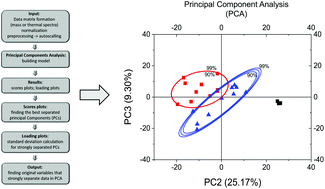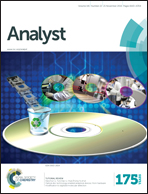Comparing surface properties of melanoma cells using time of flight secondary ions mass spectrometry†
Abstract
Various techniques have been already reported to differentiate between normal (non-malignant) and cancerous cells based on their physico-chemical properties. This is relatively simple when studied cancerous cells originate from distant stages of cancer progression. Here, studies on chemical properties of two closely related human melanoma cell lines are presented: WM115 melanoma cells were taken from the vertical growth phase while WM266-4 from the skin metastatic site of the same patient. Their chemical properties were studied by two techniques, namely time-of-flight secondary ion mass spectra (ToF SIMS) and photothermal microspectroscopy (PTMS), used to record mass and photothermal spectra of cells, respectively. In our approach, independently of the spectra type, its full range, i.e. masses and wavenumbers within the range 0–500 kDa and 500–4000 cm−1, underwent a similar methodology for principal component analysis (PCA). PCA outcome shows results groupped depending on the sample type (either WM115 or WM266-4 cells). The results are independent of the method applied to study chemical properties of melanoma cells, indicating that cancer-related changes are large enough to be identified with these techniques and to differentiate between cells originating from vertical growth phase and skin metastatis.


 Please wait while we load your content...
Please wait while we load your content...